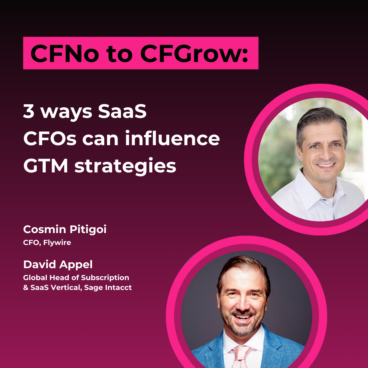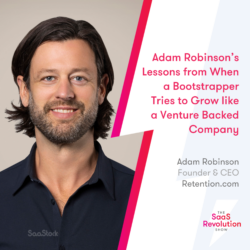Growth-stage SaaS CFOs have a reputation for saying ‘no’. With responsibility for record-keeping, cash flow, budgetary control and regulatory compliance, SaaS finance leaders have been more likely to pull the brakes on growth than twist the throttle – until now.
Today, thanks to their unique position within the company and the huge amounts of internal and external data at their disposal, growth-stage SaaS CFOs can inform financial strategies and help GTM leaders achieve their growth targets.
In other words, SaaS CFOs have gone from being a CFNo to a CFGrow.
Why SaaS CFOs have shifted gears on GTM
In a word: data. From consumer behaviour and market trends to SaaS metrics and sales numbers, today’s SaaS CFOs have access to more valuable data than ever before, enabling them to play a leading role in the growth of the company, rather than a blocker.
“If I’m a CFO and I don’t have clarity on the business, I have to say ‘no’ as I need to take the conservative point of view to manage cash,” says David Appel, Global Head of Subscription and SaaS Vertical at Sage Intacct, the world’s largest provider of software for CFOs. “But when I’ve got visibility on what’s going on and confidence in our business model and product market-fit, that empowers me to be a CFGrow.”
As growth-stage SaaS companies look to navigate an increasingly complex, uncertain and competitive market, CFOs are in a unique position to lead the way. With their insights into how every department is functioning, CFOs can not only fund and drive growth initiatives, but do so in a way that attracts investors and ensures profitability down the line.
3 ways CFOs can positively impact GTM strategies in 2025
1. Get a deep understanding of business operations
Post Series A, scaling SaaS is all about building repeatable processes and CFOs are best-placed to lead this journey. According to David Appel, SaaS CEOs are the outward-facing, positive ones with a vision, but “CFOs are the ones building the repeatable durable business model that’s going to fund it.”
However, finance leaders can only build a strategic model if they have a deep understanding of customer needs and GTM operations. “As a finance leader, you need to spend time in the business, understand the operations side and understand the strategy,” says Cosmin Pitigoi, CFO at Flywire. In particular, the CFO should work out “what the funnel looks like, how big is the market, how many people can we attract, how to earn their business and how to grow the account over time,” says Appel.
2. Collaborate with GTM leaders
SaaS CFOs traditionally work directly with their CEO, but modern SaaS CFOs need to build consensus among leadership teams and other C-suite executives to attain the company’s growth objectives. Instead of adopting the stubborn stance of a CFNo – i.e. rejecting GTM leaders’ proposals and telling them to ‘get things done’ – the modern CFGrow engages with with GTM leaders, finding out what they want to do and then using their knowledge of the company’s finances to help make those plans a reality.
For example, Cosmin Pitigoi argues that CFOs should “become the right hand to the sales team. Help them optimise the sales funnel, compensate the sales team well, think of multi-product complex sales and make sales more data driven.”
Early on, customer acquisition costs are very important, so the CFO can also help sales leaders better understand the margins on their bundle of products and price them accordingly. “CFOs should take calls with the sales team and devise a strategy for pricing,” says Pitigoi. “Start by understanding the business strategy and then build the pricing strategy underneath.”
3. Be the single a source of data truth for the company and investors
The modern SaaS CFO should have the skills of a data scientist: analysing huge amounts of internal metrics and external market data, then turning these data points into tangible operational wins. “I think of finance as the central nervous system”, says Pitigoi. “There’s no other function in the company that truly has a view of all the numbers and data and be the source of truth.”
As the oracle of data, the CFO can not only help GTM leaders make growth decisions as they scale, but act as the truth teller to the CEO and investors. “CFOs must be good at telling the story of the data and translating the data into investor’s language,” says Pitigoi. David Appel echoes this belief, noting that CFOs need to turn data “into a narrative model that investors can trust using metrics.”
Be it using financial metrics to show the growth of the company or highlighting the path towards profitability through falling CAC, modern SaaS CFOs can pull the growth lever of the GTM machine by convincing investors it’s worth their while.
What’s next for SaaS CFOs
Modern SaaS CFOs have evolved from being a defensive blocker to acting as the company quarterback: using their unique position to influence growth across the GTM function. And the role is still evolving.
Check out the full interviews with David and Cosmin over on YouTube to hear more about the role of the CFO, the impact of AI on the finance function, and more.





